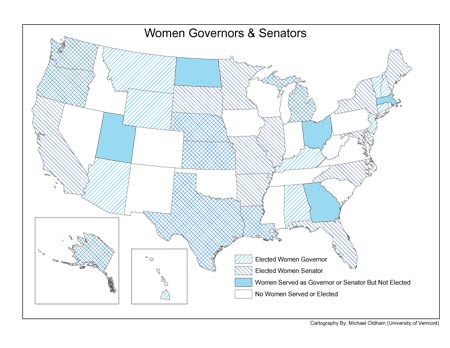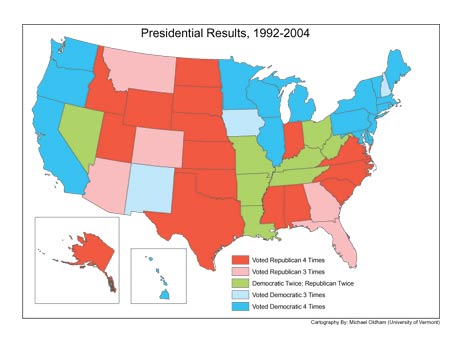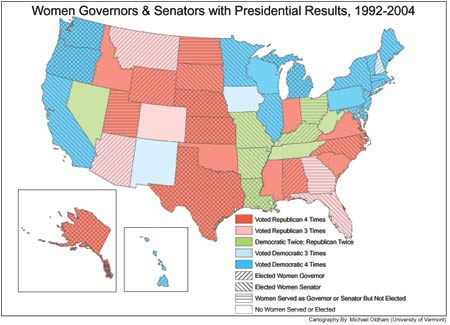Mapping a Path for
a Woman President
By Garrison Nelson, with maps by Michael J. Oldham

Of the 219 years since 1789 that the United States has functioned under the Constitution as a republic, white male Protestants have held the White House for 216 of them - 98.6 percent of the time. It took two Constitutional amendments - the Fifteenth in 1870 enfranchising African-Americans, and the Nineteenth in 1920 enfranchising women - to broaden the base of the electorate… but the post of Chief Executive has yet to be broadened.
That the Democratic Party - created in the South by one slaveholder, Thomas Jefferson of Virginia, and reshaped by another, Tennessee's Andrew Jackson - should be the political party with the most diverse presidential and vice presidential nominees is one of the great American ironies. It was the political devastation of the Civil War that obliged the Democrats to reach beyond the South and to rebuild itself with the votes of European immigrants - Catholics and Jews - who found economic hope and political freedom in the cities of the North. No surprise that it is the Democrats who have over the years chosen three Catholics - Al Smith, John F. Kennedy, and John Kerry - and the Greek Orthodox Michael Dukakis - to head their ticket and to include as vice-presidential running-mates the Catholics Edmund Muskie, Thomas Eagleton, Sargent Shriver, and Geraldine Ferraro - and Joe Lieberman, an Orthodox Jew.
The Democrats have dramatically revealed a commitment to diversity in 2008. Starting the year, three of its top four candidates - U.S. Senator Hillary Rodham Clinton of New York, U.S. Senator Barack Obama of Illinois, and New Mexico Governor Bill Richardson would, if nominated, have been either the nation's first female, black, or Latino major party presidential nominee.
With Senator Clinton and Senator Obama currently running stride for stride to the nomination, it is the Democrats who are breaking further diversity ground. Since Reconstruction ended 130 years ago only two states have sent blacks to the U.S. Senate - Massachusetts and Illinois - and only two states have elected black governors - Virginia and Massachusetts. With those three states totaling 46 electoral votes, there would seem to be no positive track record for African-American candidates like Senator Obama to build on. The history for Latino-American leaders like Governor Richardson is similarly limited with five Latino governors elected from New Mexico and one from Florida (who is also one of six Latino U.S. Senators elected from only four states - New Mexico (3); Colorado, Florida, and New Jersey). The electoral vote tally in these four states is 56, slightly better than the tally recorded in the states with statewide elected African-American leaders.

And with only the dismal showing of vice presidential nominee Geraldine Ferraro on Walter Mondale's 1984 ticket that lost 49 states, Senator Clinton would appear to have similar difficulty. However, there is positive news for Clinton in an examination of women who have served as state governors and U.S. Senators. Twenty-nine women have served as governors of 21 states, and 35 women from 22 states have served in the U.S. Senate. Thirty states have had a woman elected as governor or U.S. Senator containing a total of 354 electoral votes - 84 more than the 270 required in the Electoral College. Adding the 55 electoral votes from the five states with women governors or senators who served but gained office through unelected succession to the governorship - Massachusetts, Ohio, and Utah - or as U.S. Senate appointees - Georgia and North Dakota - raises the total number of electoral votes in states with females holding major office to 409 - 139 more than required for victory. (The data for women governors
is documented in Map 1.)
An examination of the voting patterns of the states in the last four presidential elections - 1992 and 1996 won by Senator Clinton's husband Democratic President Bill Clinton, and 2000 and 2004 won by Republican President George W. Bush - was used to determine state propensities to select a Democratic nominee like Senator Clinton. The state electoral decisions are presented in Map 2 with 18 states recorded with four Democratic victories; three states with three Democratic victories; eight states on the winning side which evenly split with Democratic victories in 1992 and 1996 and Republican ones in 2000 and 2004; five states with three Republican victories; and 16 with four Republican victories.
In Map 3, the states are placed into five categories - 1) nine states with women serving as both governor and U.S. Senator; seven cases with women elected to both offices and two with elected governors and appointed U.S. Senators - Alabama and Nebraska.; 2) ten states in which women were only elected governor; 3) eleven states with women only elected to the U.S. Senate; 4) five states where women served as governor or U.S. Senator but filled vacancies without being elected; and 5) fifteen states which have yet to have women serving as governor or U.S. Senator.

Once categorized, the 2008 electoral votes were tallied in each category, multiplied by four for the previous elections, and the percentage of times that these categorized states voted Democratic was computed. This was a rough approximation of the number of electoral votes within each women-accepting state category that presumably would have a propensity to vote for a female presidential candidate.
While the 30 states that have elected women to the Senate and the Governorship contain 354 electoral votes, their Democratic propensity in the past four elections reduced the number to 228 electoral votes - or 42 less than victory. The good news for Senator Clinton is that among the 20 states yet to elect women to the Senate or Governorship are such Democratic presidential strongholds as Massachusetts, Pennsylvania, Rhode Island, and Wisconsin. Their 47 electoral votes and the three from the District of Columbia would give her an Electoral College total of 278 votes and an 18 vote victory. It would be close and it would be enshrined in history along with those other nail-biting contests: Rutherford B. Hayes' one vote victory in 1876 (185-184); Woodrow Wilson's 23 vote victory in 1916 (277-254); and George W. Bush's five vote victory in 2000 (271-266).
With a few months to go until the 2008 Democratic Convention and the general election following quickly after, the questions before the nation are clear. Will the Democratic Party, the defender of slavery before the Civil War and racial segregation after it atone for its unfortunate legacy by nominating the first African-American presidential nominee? Or will the states that have placed women in their most powerful positions - the U.S. Senate and the governorship - rally around Senator Clinton at the Democratic convention as its nominee, and then go on to elect the nation's first woman Chief Executive?
In any case, a bumpy ride awaits us all.
Garrison Nelson is Professor of Political Science at the University of Vermont. Michael J. Oldham is a senior in the UVM Department of Geography.
|

